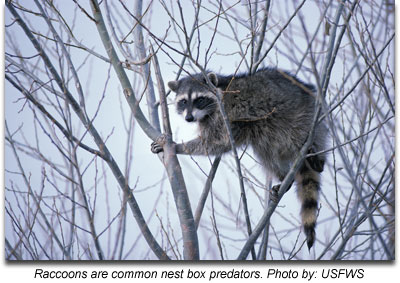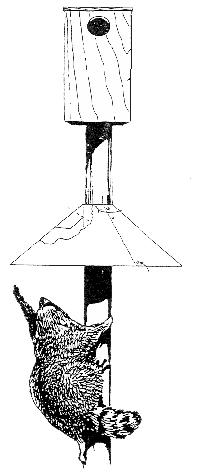Nest boxes are a great way to provide nesting habitat for a variety of birds. However, those nest boxes may also make nesting birds vulnerable to predators. Cats, squirrels, raccoons, opossums and snakes can all be nest box predators. If you have cats, then to protect your nest boxes and backyard birds it is best to keep cats inside. One study found that as many as 19 million songbirds were killed each year by cats, just in the state of Wisconsin! One effective solution to deterring nest box predators is to use predator guards. Predator guards are simple to build, easy to install, and can save you and your bird guests a lot of heartache.

Basically, most predator guards prevent predators from climbing up the nest box post. A few predator guard types, like Noel guards, discourage predators from reaching into nest boxes. However, these guards do not deter snakes. No guard is 100% effective, but choosing the right predator guard can increase the chances of having successful broods. It should be noted that mounting nest boxes on trees is generally discouraged as climbing predators can have easy access to your nest box. A metal sleeve can be placed around the tree trunk to deter some predators, but the sleeve should be designed so it doesn’t girdle the tree. Metal sleeves should also be greased and rubbed with cayenne pepper.
The following information delves into two common predator guards for nest boxes as well as instructions on how to make them yourself.
Stovepipe Predator Guard
The stovepipe predator guard was designed by Ron Kingston in order to deter snakes, squirrels, raccoons, opossums and cats. This guard basically is a pipe that you place on the nest box pole.
Materials:
- 24” long galvanized stove or vent pipe without a seam, approximately 8” in diameter
- 9” circle of hardware cloth (or 1” larger than stovepipe diameter)
- 2 7” long hanger iron straps (aka plumbers tape)
- 2 No. 8 B32 x ¾” machine screws and nuts
- Tin snips
- Leather gloves
Directions:

- Construct and place the baffle on the nest box pole BEFORE the nest box!
- Use tin snips to cut a small hole or “x” in the middle of the hardware cloth circle to slide your mounting pole through it
- Put the circle over the top of the stovepipe and then bend the edges down around the pipe. Be sure it fits tightly inside the stovepipe.
- Cut 4 small tabs in the top of the stovepipe and bend these over the hardware cloth.
- Bolt the 2 hanger iron straps securely on either side of the mounting pipe using machine screws and nuts. Bend the hangars to support the hardware cloth. Duct tape or electrical tape can be used to hold the hangar iron in place.
- Be sure that no gaps exist between the hardware cloth and the stovepipe. Any gaps would allow snakes to squeeze through to reach the nest box.
- Slide the stovepipe assembly over the pole and allow it to rest on the hangar irons. The top of the baffle should be at least 4 feet off the ground to be effective.
For extra protection, smear heavy-duty wax along the pole to create a slippery surface that also repels ants. A wobbly guard discourages climbing predators. If the stovepipe begins to rust, then be sure to sand it down and paint it as snakes can use the rough, rusty surface to climb up the pipe.
How to Build a Cone-Shaped Predator Guard
This type of predator guard is shaped like an inverted cone. Conical guards are easier and cheaper to make than stovepipe baffles, however, they aren’t as effective- especially against raccoons. If you want an easy to build guard, then conical guards are much better than no guard at all! Place the cone at least three feet from the ground or water where the nest box is located.

Materials
- 3' x 8' sheet of 26 gauge sheet metal
- Three wooden mounting blocks
- Galvanized nails
- 1/4" round head stove bolts or metal screws
- Tin snips
- Leather gloves
-
Design illustration courtesy of USFWS
Directions
- Mark the sheet as shown on the design illustration. This design will make three predator guards.
- Cut on solid lines only and follow the sequence of numbers.
- Make circular cuts in a counterclockwise direction. Adjust the center hole cut to match the diameter of the post.
- To make the initial cut on line A-B; make a slot at A with a cold chisel.
- Be sure to wear gloves when cutting.
- Fold the metal circles over to make cones and overlap at the dotted lines.
- Attach the overlapping area together with round head stove bolts or metal screws.
- Attach the wooden mounting blocks to the post so that the predator guard can rest evenly.
- Place the predator guard over the post before attaching the nest box.
Specific Predator Guards
Invite Wildlife to Your Backyard!
For more information, please contact:
Maryland Department of Natural Resources
Wildlife and Heritage Service
Tawes State Office Building, E-1
Annapolis MD 21401
410-260-8540
Toll-free in Maryland: 1-877-620-8DNR
[email protected]
Acknowledgements:
- Photo of raccoon in tree by USFWS